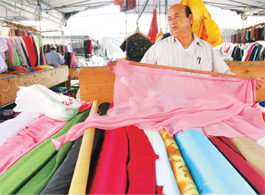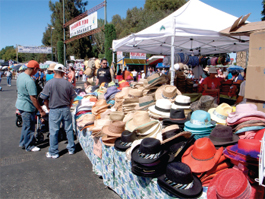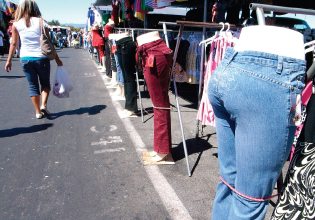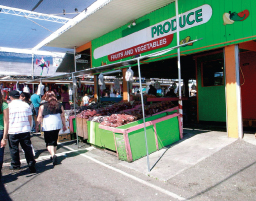home | metro silicon valley index | news | silicon valley | news article

Photographs by Felipe Buitrago
Social fabric: Harminder Kanda of Kanda Fabrics has been able to rent a storefront on Capitol Expressway in addition to his space at the San Jose Flea Market, but he wonders what will happen to other vendors if the local institution disappears.
Live Flea or Die Hard
With the future in doubt for the San Jose Flea Market, one more door closes for Silicon Valley's working class
By Erin Sherbert
MARLYN CORDOVA and her family aren't waiting around to see if the San Jose Flea Market will stay open for business.
She and her mother already found another storefront in San Jose, where they are paying double the rent to sell their merchandise—children's baptismal clothing.
San Francisco.com Real Estate
Moving to the Bay Area just became easy. Let San Francisco.com show you all the homes currently for sale.
San Jose.com Real Estate
Relocating to San Jose or Silicon Valley? Let San Jose.com introduce you to some expert area real estate agents.
Gentle and soft-spoken, Cordova, 28, explains how her family feel they have no other choice. The 47-year-old flea market is set to close within the next few years as operators make way for a housing and retail village—and there's no guarantee the market will be relocated.
But her reservation breaks when she starts talking about how other vendors—who have become her friends over the years—won't be so lucky.
Many sellers at the flea market are too old to start all over again or take on new jobs, Cordova explains. Others just won't be able to afford the higher rents at other stores in San Jose.
"It's a big concern. Everyone is used to coming here," Cordova said as she stood under the white tarps at the market with her infant daughter at her side. "It's not fair if they shut us down and tell us to go look for another job."

Hat topic: Can the flea market be relocated? The operators are considering alternative sites, like the Santa Clara County Fairgrounds.
For Cordova and other vendors, the market is more than a place of business. It's like a second home, where they have formed close-knit friendships and established customers. Market operators said they want to find a new location for the successful flea market, but they're not making any promises.
Securing a 120-acre site to accommodate the nation's largest open-air market is a challenge, as land in the Silicon Valley is scarce and expensive.
At the same time, vendors don't want the market to move outside the San Jose community, where they have made their homes. "It's a big issue for us," Cordova said. "If they move, we will go along if it's in San Jose. If it's far, it will be too hard to commute."
More than a cultural experience, the flea market has served as a significant opportunity for San Jose's working class to run a business cheaply.
That could change if the market is relocated. Vendors will likely face new pressures, including higher rents and steeper operating costs, said Joseph Horwedel, San Jose's director of planning.
"The challenges of keeping blue-collared jobs in a high-cost areas like the Silicon Valley is something the city grapples with continually," Horwedel said.
Paving the way For BART
In 2002, the city amended its general plan to allow for roughly 2,800 homes, 365,000 square feet of retail and 36 acres of open space on the Berryessa Road site.
The plans for rezoning the property to commercial and retail is headed to the City Council for a final vote on Aug. 14.
This development would create more jobs and opportunities for affordable housing; it would also be a critical element in getting BART to San Jose.
Right now, about 80 percent of the BART project cost is covered, yet transportation officials are looking for federal dollars to help pay the remaining balance, city planners said.
The city will be better positioned to capture federal dollars if its planned BART stations are near potential riders.
The Berryessa Road BART station will be built adjacent to the flea market site. Having a cluster of homes and jobs near that station will boost the city's chances of garnering federal money.
Market operators have committed to keeping the flea market open for at least another two years while they continue looking for a new site.
They have spotted the Santa Clara County Fairgrounds as a potential site large enough to accommodate the entire flea market.
They are also considering other locations near the southern and eastern parts of the county, where a majority of the flea market customers live, said Erik Schoennauer, a land-use consultant representing the owners of the San Jose Flea Market.
"There are no guarantees, but the owners of the flea market are committed to trying to find a new location," Schoennauer said. "The flea market is a very successful business and there is a lot of motivation to keep it running."
But it's hardly been a moneymaker for the city.
The flea market generates less than $300,000 annually in sales tax dollars for the city, said Nanci Klein, manager of corporate outreach for the city's economic development department.
In comparison, the planned housing and retail development will create many jobs and boost sales tax revenue for the city, economic leaders said.
"The density of the uses will generate significantly more revenues, but how much? I can't tell you," Klein said.

Scenes from a flea: Clothes and produce are two of the things the San Jose Flea Market is known for.
Flea History
The market opened in 1960, after a local solid waste worker, George Bumb saw so many useful things were being tossed into landfills.
He wanted to find a profitable way of recycling these items. So Bumb traveled to Los Angeles where "swap meets" were growing in popularity. After seeing how these events were organized, Bumb got $7,000 in cash and looked for a site to start his own flea market.
Bumb found a large piece of farmland on Berryessa Road and opened what is now the nation's largest open-air flea market, according to its website.
In the beginning, the family-owned market operated with 20 sellers and attracted about 100 customers. The small market quickly grew, becoming a fixture in the San Jose community, where customers stroll through the rows of stands to find jewelry, clothing, furniture and food at knock-off prices.
Each year, the market attracts about 4 million customers, who come to get the best deals while eating authentic ethnic food and listening to international music.

More scenes from a flea.
'How will they survive?'
Already, many vendors are making other plans, preparing for the day the market closes. Some are shutting down permanently while others are looking for new jobs.
"Everyone is disappointed," said Harminder Kanda, who sells Indian fabrics at the market. "How will they survive?"
Despite the market's uncertain future, Kanda said he is not going to worry about his business. On top of his flea market stand, the India native is paying double to rent out a storefront on Capitol Expressway where he plans to move his entire business once the market closes.
Other vendors aren't dwelling on the future just yet.
Ranbeer Kaur said she knows the market will close eventually. She is not counting on operators to relocate it.
But for now, she doesn't want to worry about the future. Kaur, who with her husband has sold tents and tools at the flea market for the last 15 years, said she isn't going to make any plans for her business until she knows for certain whether the flea market will move.
"I don't want to think about it, I don't want to stress," Kaur said with resignation. "I don't think they will relocate it."
Send a letter to the editor about this story.
|
|
|
|
|
|
